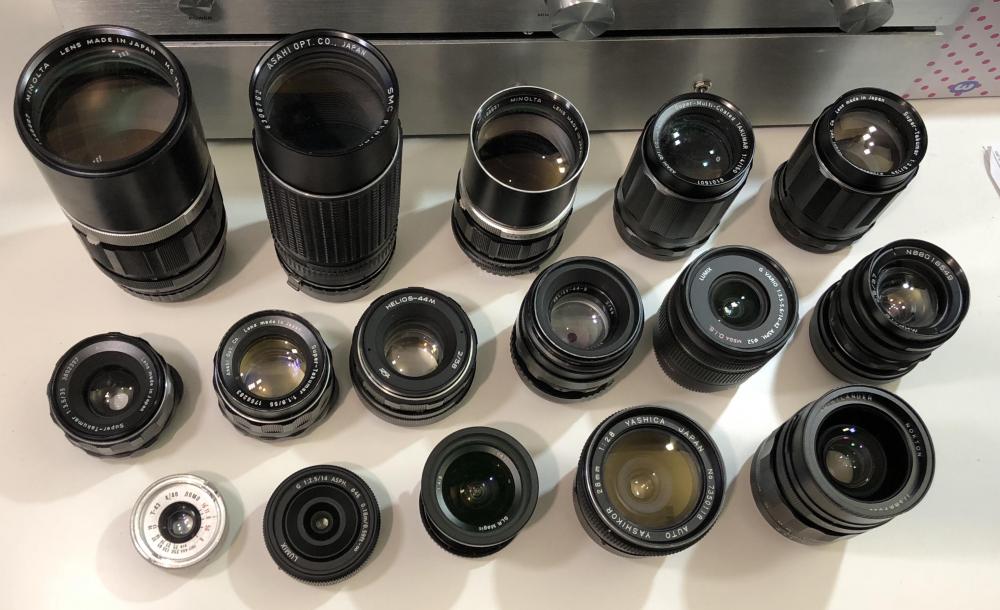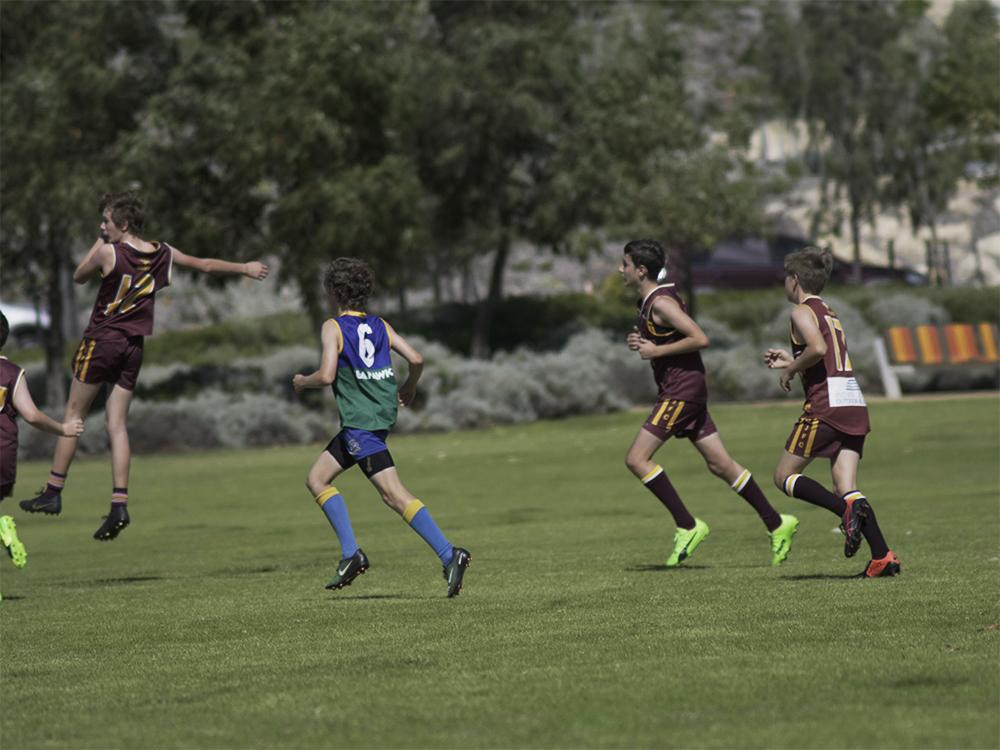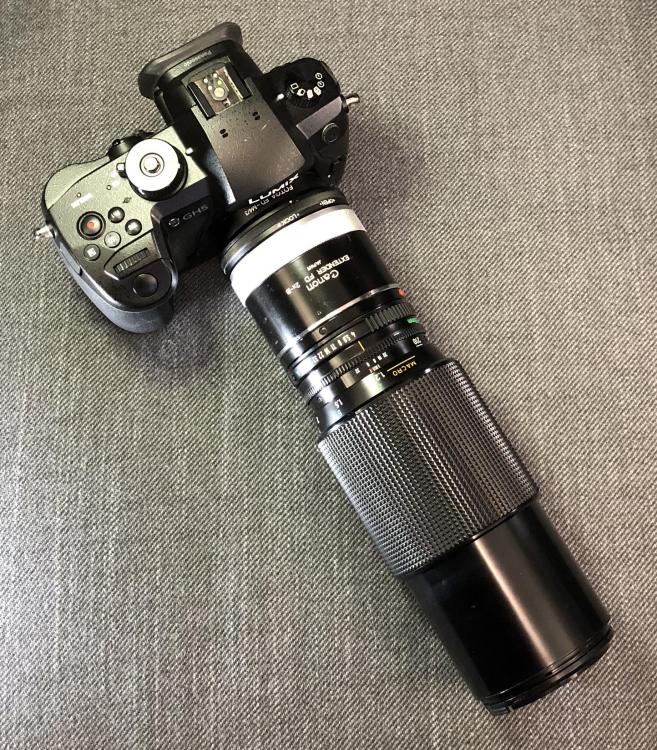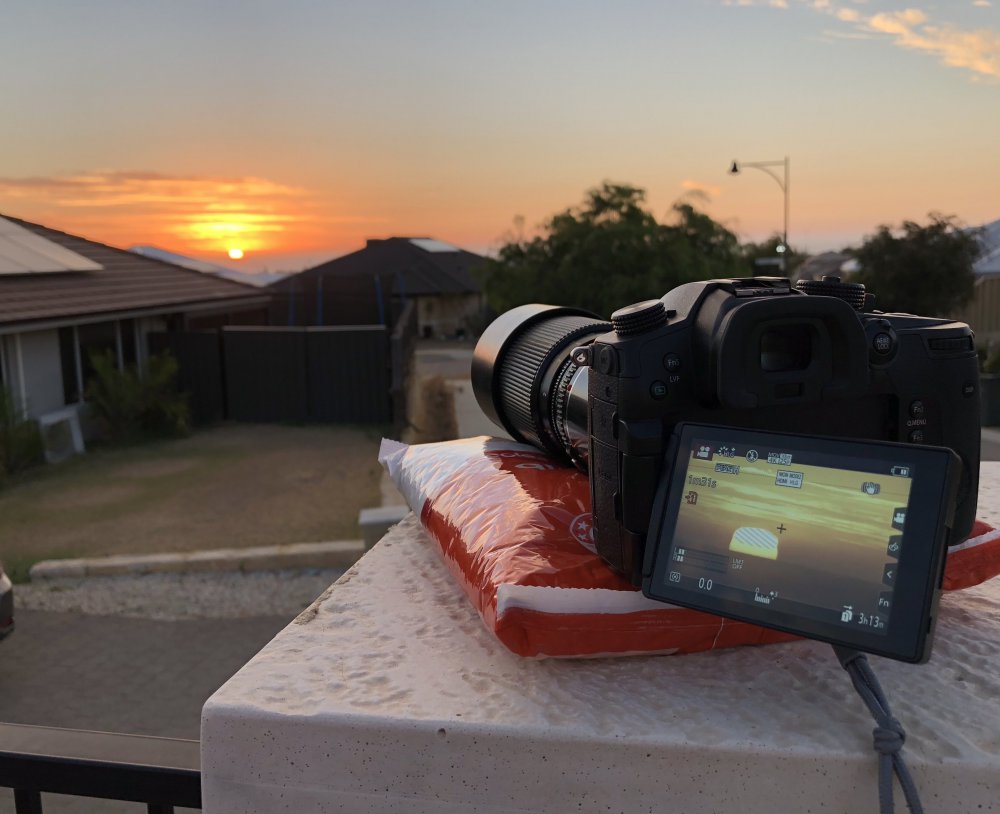-
Posts
7,835 -
Joined
-
Last visited
Content Type
Profiles
Forums
Articles
Everything posted by kye
-
and get rid of our smartphones and any 'smart' devices with a microphone. they're all listening...
-
GH5 with Canon FD 70-210/4 and 2X FD TC sitting on a packet of oats for lens support and stabilisation. I shoot a lot with long lenses for sports. Here's some random pics... I haven't been that enamoured with the FD as it's a bit soft at the longest end, although I'm being super picky as I'm recording on MFT, using a 2X TC, and sometimes using the digital 2X zoom or ETC mode to crop in further. This is equivalent to expecting the lens to have a resolution of ~250Mpixels, which is obviously ridiculous for a vintage zoom lens! I was contemplating getting a better L-series zoom from the same time, but have since re-evaluated and now I'm not so sure. My latest "long lens" setup is my Voigtlander 42.5mm / f0.95, which on MFT is an 85/1.9 equivalent. That's not a long lens for most people, but I've discovered the 2X digital zoom on the GH5, which downsamples a ~2.5K sensor area to a 1080p image, thus keeping all the downsampling goodness, and turns the lens into a 170mm / 3.8 equivalent, which probably is a "long lens". Of course, I bought the 42.5 in late 2019 in anticipation of the many trips we had planned in 2020, so naturally it's basically only done test shots in the backyard, so it's both an old purchase that I've practically forgotten about and also a completely new lens I haven't really used yet!
-
I'm sticking with the GH5 and concentrating on ironing out my colour grading and image processing workflow more. Beyond that I'm thinking more about editing style and how to get better at that. I watched the below videos recently and found them interesting, so they might be useful for those who aren't sure about what's good for what applications. This guy rates cameras against a few different types of productions, and rates the A7S3, FX6, C70, Komodo, and threw the P6K in there too. This guy rates cameras on a different scale and includes more cameras:
-
That makes sense about it being about how good the sensors are. The GH5 sensor must be getting old now.. In terms of colour science, if you're good enough then anything can be made to look like anything, but the problem is that those levels of skill are pretty rare, even amongst professional colourists! I would also suggest that the pursuit of IQ can be had either by having deep pockets or by being radically inconvenienced - there are some older cinema cameras that look great (for example the F3, BMMCC, etc) but compared to a modern DSLR/MILC they're a royal PITA.
-
I guess we're getting into tricky territory here, but I have the rather unpopular opinion of only caring about the user experience and the image. My passion for the size of the sensor is about the same as my passion for the number of letters in the part number of the audio processing chip - both have virtually no impact on the end result!
-
Yeah, this is a major issue. It's because the environment for colour management is basically a huge mess, and why BM still sells and recommends their own hardware monitoring - because it bypasses all the OS and UI colour tomfoolery. I read in one thread about applying an extra node in Resolve to compensate, I think it was a gamma conversion of some kind, and the idea is that you just grade as normal, apply the extra node, export, then disable the node again. I've found it makes a pretty close match, including all the way to viewing your video on YT, certainly close enough considering the woeful variation in colour performance of the various devices out there.
-
I just did a little test with ffmpeg, and encoding the ALL-I was twice as fast as encoding the Long-GOP file. So ALL-I should generate half the heat, so that's not it.
-
I feel like learning about NR is one of the things that really helped me get good results from my footage. I also think it was one of the things I understood the least. Certainly, the internet is full of people complaining about their cameras ISO performance. I'm sure that Sony sold a lot of A7S2s because people didn't really understand NR. In reality, cinema cameras that Hollywood uses are some of the noisiest cameras still currently in use - most consumer cameras have better noise performance! Here's a great tutorial about how to do it in Resolve, and as Waqas says, this might be the biggest reason to buy Resolve. Certainly it was when I bought it. I'd previously struggled in my own footage, especially when I did a bunch of things wrong because I didn't know what I was doing early on! But I was able to start with this C-Log 8-bit 4K image: Grade it to this: and then turn this level of noise: Into this: Perhaps the greatest challenge with the Canon footage is that the noise is in large blocks, rather than single-pixel noise which is easier to get rid of. My Canon 700D was the same, even in RAW, so maybe it's a Canon thing. As the combination of temporal and spatial NR combines adjacent pixels (which you can then sharpen back up again as Waqas shows above) it also helped turn this obviously 8-bit and heavily expanded / broken colour space: Into a much smoother colour rendition: It's not magic, but it's definitely a much better result than just living with the noise or binning shots that had a bit of noise in them for whatever reason. The thing that surprised me the most is that due to the noise from older cine cameras, basically every production shot on a cine camera will have NR applied like this. Once I learned that it seemed odd that consumers were expecting to have cameras that had no noise, when the high-end cameras don't perform like that!
-
@Mark Romero 2 @SteveV4D @herein2020 Good conversation, and I think it's actually clarified things for me. I don't have any issue with people shooting 4K, or 6K, or freaking 12K if they really want, but I think the issue I have is that people do so without really knowing what choices they're making. I'm speaking more broadly, and you guys may be well aware of the pros and cons, but many people reading this aren't posting or even logged in, so I'm conscious of those people, rather than just you guys 🙂 I think the issue is how we talk about these things. People talk like 4K has no downsides. When you bring them up, they get countered individually, and the net result seems to be that the arguments against 4K have valid counterarguments, but that's kind of a false impression. It's like.... "4K takes more processing power to edit" - "yeah, but modern computers are fine, so that's not enough reason to swap" .... 4K: 1 point, 1080p zero! "4K lets you crop in post" - "1080 is pretty good though" - "but not as much as 4K, so that's not a reason to swap" .... 4K: 2 points, 1080p still zero! "4K is what some clients ask for" - "that doesn't mean 4K is always the right choice" - "yeah but some do" .... 4K: 3 points, 1080p still zero! etc. It looks like 1080p scored zero points, but the problem with this logic is that it's just not true. 1080p won a few and came runner up in most of them. If the scores were a percentage rather than a winner/loser mentality then an overall score might be something like 4K 70% and 1080p 55%, but when you talk about 1080 people don't say "I've weighed up the pros and cons", they just look at you like you're suggesting they film with the lens cap on. Unfortunately it creates a situation where new people don't understand there's a choice to be made, and that depending on what you value more, the winner can be flipped to 1080p without that much effort because it's actually a much closer argument than people think. That makes sense and is very sad actually. It means that Panasonic will have taken the video features of the GH5 and essentially doubled their price. Also, they've smashed the S5 with the Canon Cripple Hammer in order to protect their own line of 'cine' cameras. Panasonic used to be the underdog who gave what they could, rather than the big corporate who took all they could. Assuming it's true, it's not a good look.
-
I just think it's sad that clients are asking for 4K. I think in reality most of them couldn't tell if you shot 1080 and then just sharpened it and then exported at 4K, but obviously doing that on commercial jobs isn't a good move. It's kind of funny that clients who want an ad for their business to put on social, or a promo for their whatever to put on TV in-stores want 4K, when 8 and 9-figure Hollywood films are being delivered at 2K. Do they think more resolution is better? If so, why do they think they need more resolution than a Hollywood film that will be projected on cinema screens a couple of stories tall? If they don't think more resolution is better then why ask for it? It just doesn't make any logical sense. In terms of Potatojet and the Alexa footage - I wasn't comparing the Alexa to the M50 outright (it might have sounded like that though) I was more saying about how the Alexa just looks spectacular and it's really obvious. Watch that footage at any resolution you like on YT and you'll see that the resolution/compression settings of YT don't take away that magic. The Magic of Alexa isn't in the resolution. That's why having cameras without the magic of the Alexa and adding resolution is kind of stupid - they're fixing the part of the camera that wasn't broken. Cropping heavily in post is an argument that seems to make sense, but really has its limits. Have you done a comparison between cropping into 150Mbps 4K and 200Mbps 1080p? or are you just blindly assuming that more is better? You seem to be latching onto the comparison between Long-GOP and ALL-I as the comparison between 150Mbps 4K and 400Mbps 4K, but that's not the comparison I'm making. I'm comparing 150Mbps 4K and 200Mbps 1080p. You're starting off with the assumption you need 4K, but until you've tried it you can't really comment with much certainty. AF is a great point - so let me phrase it like this... If you had ALL-I on the GH5 and then the S5 didn't have it, that would be an additional factor on top of the AF that would steer you towards a different brand. One thing that really makes the GH5 stand out are the codecs. I didn't limit myself to 1080p. I upgraded to ALL-I, upgraded from 150Mbps to 200bps, and upgraded to the resolution that many Hollywood films are shot in. You wouldn't know it from these 4K fanboy discussions, but people that have budgets of hundreds of millions of dollars for a film, and who win awards for making glorious images actually choose <3K resolutions by choice. Think about that for a second.. When they could have anything they want, they actively choose 2K. Do you think there's a reason that they might do that? 4K video in the kind of codecs we're talking about is closer to 2MP in resolution, so why quibble about 8MP vs 12MP 🙂 I love 4K. In fact, 4K is enough for me. I shoot 5K. and I shoot 5K RAW and then downsample it to 2K. I just do it all in-camera. In terms of reframing - try it for yourself. I've done the tests and I realised that you can push the image much further than I thought. You'll find me one these forums talking passionately about 4K and reframing, you'll find that I did the tests, and you'll find that I changed my mind. I must admit the Panasonic colour science has gotten a lot better since the GH5, that's for sure. It would just be great if they put the good codecs into the S5. For me, the S5 isn't a GH5 replacement.
-
I used to shoot 150Mbps Log-GOP 4K, and really liked its texture, which I found to be quite analog. But when I compared the IQ to the 200Mbps 1080p ALL-I mode and learned more about IQ in general, I realised that the difference wasn't that much. ....then when I realised I can shoot 200Mbps 10-bit 422 ALL-I 1080p in both 24p as well as 60p, I saw an enormous opportunity to be able to match the 60p clips I shoot to the 24p clips I shoot. Getting 10-bit 422 ALL-I 60p is a pretty rare thing, even in the latest cameras. ....then when I realised I can edit the 200Mbps 1080p from my archive spinning disks without having to render proxies, well, game over! Nah, YT compression shouldn't be blamed. Go watch the Potatojet vlog where he buys the Alexa - he's vlogging the whole thing when they take the Alexa out and get a shot of the train and as soon as they cut from his vlogging camera to the Alexa the image just goes from 4/10 to 10/10 instantly. Then watch that transition in YT 1080p. Then in YT 720p. Then 480p. Then 360p. You will see that the YT compression does not erase the magic of the Alexa colour science and DR. I switched to 1080p partly because I realised that what matters in an image isn't resolution, it's DR, CS, etc etc. I compared them, and I can say there's a HUGE difference between 150Mbps and 400Mbps. The cost of the SD card!! The lack of 10-bit internal 60p is only a problem for those that still think that 4K is worth the effort. A good comparison to make is 10-bit H265 4k 60p vs the 1080p 10-bit 422 ALL-I 60p mode. I think the difference would be absolutely enormous, in terms of editing computer, and basically negligible in terms of image quality. I mean this sincerely too, actually do some testing where you take the 1080p footage and apply various types of sharpening and processing to it to try and match the 4K. Of course, you have to do these comparisons on a timeline where both the 1080p and 4K have been graded, Glow and grain added, and the video compressed to its final delivery format. I have spent the last few months taking screen-grabs of my 4K display playing TV shows and movies (set a hotkey for screen-grab and it only takes a second) and you end up with a library of reference stills. In analysing that I have discovered that the actual sharpness of content is very low, partly because of the 180 shutter (I try and get frames where there is as little motion as possible) and partly because of the streaming compression. The images look glorious, being that they're from some of the best artists in the business, but 12MP RAW stills they are NOT. Before spending many thousands to get a camera that can do 10-bit 4K 60, and thousands more to edit 10-bit h265 clips, actually confirm that the difference is noticeable to the people watching your footage. If you're making corporate videos or whatever then sure, maybe the client wants something that looks super modern (and maaaaaaaybe they can tell the difference between 4K and a 1080p sharpened a little and upressed to 4K). But if you're trying for a theatrical aesthetic, or will be delivering via YT, then actually do comparisons instead of just buying into the hype. 4K is more of a brand name or status symbol than it is a resolution these days. Yes and no. If I was upgrading from the GH5 and wanted the ALL-I modes, then maybe I get the S1H instead of the S5. But maybe I realise that I can get the A7S3 for the same price as the S1H and maybe I go with that instead. Or maybe I can't afford it and I just don't upgrade. The S5 isn't only competing with the S1H, it's competing with the S1H's competitors, and other options too. By pushing people to re-buy all their lenses then that's a point where your ecosystem has to remain attractive.
-
That makes sense. In that case, I don't know why people are saying the S5 is a FF GH5. 100Mbps Long-GOP < 400Mbps ALL-I, regardless of how big the sensor is. In fact, I shoot 200Mbps 1080p because I value the 10-bit 422 ALL-I more than I value 4K.
-
My impression was that the GH5 started off without the cool codecs and they were added later on, so I would have thought the S5 would also get updates in a similar manner. Maybe not, who knows. Certainly the GH5 was partially famous because of the ALL-I modes, so it does matter I think, although there's the whole 'undercutting your other models' thing. I've idly entertained the idea of upgrading one day from the GH5 to FF, especially if there is no GH6, but there's no way I would re-buy a camera body and all my lenses for 100Mbps Long-GOP after having 200Mbps/400Mbps 10-bit 422 ALL-I. I guess if you graph how much a 150Mbps+ 10-bit 422 ALL-I capable camera with IBIS and MILC form-factor costs then maybe that graph goes up after the GH5 goes EOL? I thought the S5 would have been that natural replacement.
-
Very cheap 50/1.2 APSC lens that seems to not be rubbish.. CA is its weakness, but for under $100 you can't have everything!
-
ALL-I gives a HUGE performance boost when editing! If I ask an NLE to go to a specific frame in a file, Long-GOP requires to find the previous keyframe and render each frame between the keyframe and the target frame. ALL-I just goes to the frame and decodes just that one frame. ALL-I footage plays backwards with the same CGP/GPU performance as playing forwards. For the same bitrates ALL-I does take a slight quality hit, but it's not that much. The bitrates aren't that different either - the GH5 has 200Mbps and 400Mbps ALL-I modes, but there is nothing stopping Panasonic from adding other bitrates as well. ALL-I is one of the reasons that BM can get a modestly spec'd computer to play 12K BRAW footage, when almost no computer on earth can play the 8K h265 files from the Canon R5.
-
I agree.. also, S1H buyers are more likely to have higher skill levels to get the most from the footage out of the camera - post processing shouldn't be underestimated - the more I learn about colour grading the more I view camera footage (even rec709 h264 files) as an unprocessed image for input to an entire image processing pipeline. Does the S5 have all the 10-bit 422 ALL-I codecs yet? I haven't kept up with it, but when it launched it was like the GH5 at launch, limited to unremarkable 72Mbps type codecs.
-
The XC10 can undercrank. I shot some pretty amazing night footage once at about 1fps, which I didn't use in the edit but was quite useful at the time because the camera could see the boat passing nearby, how far away it was, how many people were on it, and many other things, when to the naked eye the boat was completely in darkness apart from its headlights. I was talking about filming 24fps and then playing it back slower, ie 12fps / 50% speed, or lower. Most recent usage was the dramatic scene where a woman is crying and chasing a train which is pulling out of the station and has her lover on it. I felt it matched the aesthetic very well. My understanding of cinematic language is that 50p conformed to 24 is typically used in Hollywood to make something seem a bit surreal, the way we experience reality during peaks of emotion. Shooting 50p and playing it back at 24p slows time but still gives a continuity of medium, ie, it doesn't break the illusion of continuous motion. It is also a subtle speed reduction that the footage doesn't feel overly artificial, whereas 120p at 20% feels completely artificial and calls attention to itself. Having less than 24fps displayed to the audience will break the continuity of motion. This can be used to great effect for sequences where the perception of a character is highly impaired, such as due to heavy drug use, injury, or severe trauma. In situations like this the use will likely be seen as fitting into the context, but if it had no alignment to the story then it would pull the audience out of the experience and call attention to the medium, so it can't be used without careful consideration. Slowing down 24fps footage will do both of the above things - it will slow down the events to slower than real-time and it will show an altered perception of reality. This may be appropriate in situations like the point of view of a car accident victim coming in and out of consciousness, or the above mentioned woman chasing the train, but the level of emotional engagement has to be right - it would work for the woman if her lover leaving would mean that her life would be basically over but it likely wouldn't work if her lover was going away for a week and forgot his spare socks. I think frame rate effects are something that you can only use effectively when you understand the aesthetic associations involved and are using these to support the dramatic content of the story. Failure to do so is one of the things that I see with vloggers who have copied the Casey Neistat vlog formula but don't understand it, so they use slow-motion in ways that say "I just discovered this function of my camera" rather than "here's something that looks awesome in slow-motion, and the thing and the slow-motion effect are both relevant to the story". One thing that is interesting is the use of slow-motion pedestrians walking in a city. It's a stereotypical image that I find works quite well occasionally, typically when the music is on the higher-intensity end of things, but also where the context is also high-intensity. If someone always wanted to go to NY and this was their trip of a lifetime then that context might warrant it, but a NY vlogger going out to buy milk would have to try a lot harder to 'justify' the altered-state high-emotional context of that shot. The wedding film-maker shooting a wedding couple in the middle of Times Square that I saw when I was there might get away with using it in the wedding reel, as the wedding is likely a high-emotion situation too. I see film-making as a three-level thing: 1) understand the technical aspects, 2) understand the aesthetic of each technical aspect, and 3) apply the right technical choices in order to support the story at each given moment.
-
Also, F3 got a mention in one of the 2020 Best Tech videos... Fun stuff!
-
I think @mercer mentioned using a belt clip for a tape measure at one point.. ?
-
Recently I've seen a few instances where a TV show or movie slowed down 24p footage, effectively creating a <12fps shot. The interesting thing is that often these productions are modern, shot on Alexas, and could just as easily shot 50p or 120p+, but didn't. The moments that were slowed down were obvious shots for slow motion, so it's not like the editor went in an unexpected direction that the director or script couldn't have anticipated. The thing that strikes me is that it's a different effect to shooting 50p and slowing it down. A different aesthetic. TBH it seems more timeless and more emotional than the typical 50p, high-emotion, queue the big music, pivotal story moment that is commonly done. It feels more like classic cinema. Have you noticed this? How does it feel to you? Would you do it deliberately?
-
TV manufacturers are in the business of selling TVs. If you want to talk about the mis-alignment between what film-makers want, what consumers can see, and what is getting used to sell TVs, then you're wasting your time talking about anything other than resolution, and specifically 4K. Most people can't tell the difference between 1080p and 4K at normal / sensible viewing distances, and most video content even shot in 4K looks awful when viewed close enough to see the horrific compression that gets applied to it by streaming services. HDR is something that I think is worthwhile, and an argument can be made for why that should be something that is worth re-buying your TV for, but 4K in the consumer market is just a gimmick to sell things. I find that the world makes zero sense when you don't look at it from the right angle - the design of a TV isn't to give the best cinematic experience, it's to put dollars into the pockets of electronic company CEOs! Lots of discussions here on the forums are around how depressing the world has become, for a variety of reasons, and I think that a major contributor is the idea that the world should be a certain way, and that that way is different to how it is. This is simply a recipe for frustration and depression. I think Fuzzynormal said it best....
-
If you care about it that much then I'd say get more discerning friends! My experience is that people see / hear / smell / taste things differently and uniquely, not worse or better. They are likely not sensitive to the things that you are attune to, and vice versa. When I ask my wife about colour grading she has all kinds of opinions, however she doesn't know the words to use and so it's not an easy subject to communicate about, but my overall impression is that she's sensitive to different things than I am, rather than not caring. This was my experience when I was into high-end audio equipment too, it's very common for the wives of audiophiles to be able to tell that you did a minor upgrade, but without being told and by noticing it from the other room. The other thing to consider is that much of film-making is the deliberate crafting of things that other people find sub-conscious or completely un-conscious. The difference between good and bad editing for example results in the viewer being able to follow the plot vs being confused by certain elements, and this is often accomplished (especially by the great directors / editors who show and don't tell) by the careful arranging of lines, shots, and edits which the viewer will correctly interpret but likely won't be aware of. I suggest that rather than rant on the internet because the world doesn't align to your particular preferences, you take this as an opportunity to learn what they do care about and focus on that. After all, you're making content for other people, and not yourself, right?
-
I definitely agree with the sentiment "the least moves wins", although I would refine that considerably. I used to find myself basically fighting the footage, unable to get the footage to look even half-way decent. This was because my skill level was basically zero at that point. As I gradually learned, I started being able to make a few good adjustments before the 'tweaking' started doing more harm than good. Now, I think of it as a skill-level thing - the more skill you have the more adjustments you can make before you're making it worse and not better. My new workflow is now to apply a look (Kodak 2393 LUT with some blurring/texture as shown above is my current favourite but I'm adjusting and optimising over time) and then to WB, adjust levels, and do any localised corrections required, but all underneath the look. The secondaries are normally Hue-v-Hue / Hue-v-Lum / Hue-v-Sat but I will also do local adjustments if required. These are often to match shots rather than significantly push things around. I'm often doing things like darkening / desaturating distracting objects in the background or doing a large and soft power-window to brighten the subject. I regard this as being quite minimal, considering that the 2393 is by far the largest adjustment in the grade and it was created by people far above my skill level, so I'm still responsible for the minority of the grade. With my control surface I'm able to rip through an edit only spending a short amount of time per shot, by only making a few relatively repeatable adjustments.
-
Every camera has great rolloff if the DR is there, just apply a curve. If I can get a compliment on the highlight rolloff from a budget P&S camera from 2009 then there are no excuses! It's also possible to get a nice rolloff on areas that are clipped, although you don't get any detail back from them obviously. The more I learn about colour grading, the more that I realise that grading is in the same category as production design or lighting, you can't expect your footage to look great if you don't do any set dressing, hair or makeup, or just shoot with whatever light happens to be there when you happen to show up, so why would it look great if you didn't do any colour grading either?















